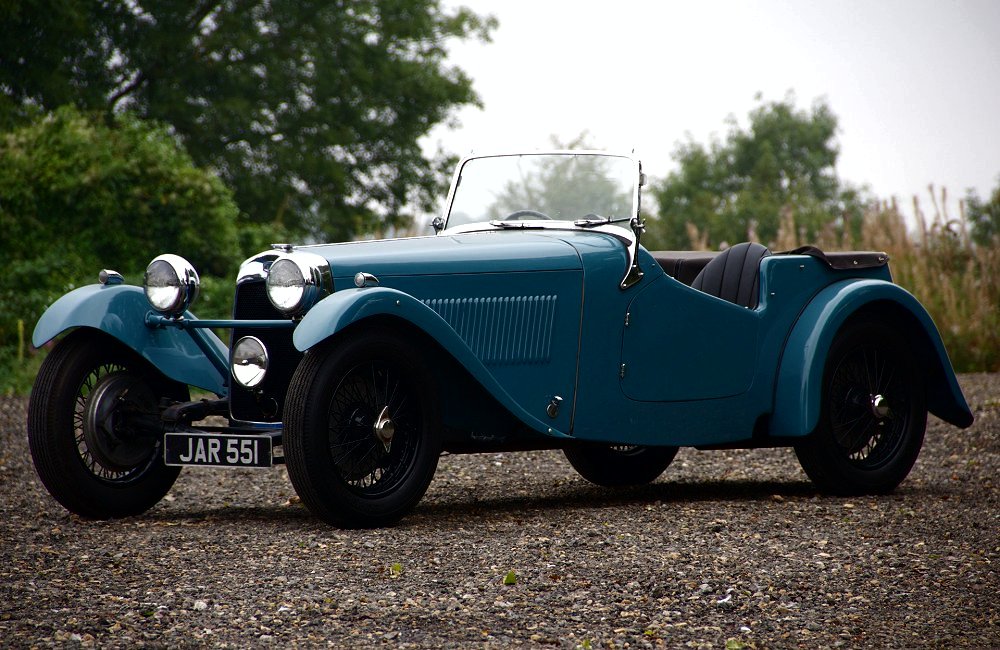Description
The HRG 1500 was the definitive model of the small but respected British sports car manufacturer HRG Engineering Company, representing the peak of the marque’s development and reputation. Built from 1939 and continuing in small numbers until the early 1950s, the 1500 combined the mechanical simplicity and lightness of HRG’s earlier cars with stronger performance, refined handling, and a growing reputation in motorsport. It was the car that truly established HRG as one of the great names in postwar British sporting motoring.
The HRG Engineering Company, founded in 1936 by Major Edward Halford, Guy Robins, and Henry Ronald Godfrey, was a small outfit operating from Tolworth in Surrey. All three men were experienced engineers who had worked with pioneering firms such as GN and Frazer Nash, and their vision for HRG was to build sports cars that were light, reliable, and fast through good design rather than excessive power. Their creations were handcrafted and mechanically straightforward, appealing to drivers who valued feel and precision over luxury.
The HRG 1500 evolved naturally from the earlier 1100 and 1½-litre models. It used a tubular ladder-type steel chassis—strong, light, and simple in layout. The front suspension employed an independent system with a transverse leaf spring and wishbones, while the rear featured a live axle located by semi-elliptic leaf springs. The steering was direct and unassisted, providing remarkable feedback, and the braking was via hydraulic drums on all four wheels. This straightforward but well-balanced configuration gave the HRG 1500 its celebrated agility and predictability, qualities that made it a favorite both on the road and on the circuit.
Power came from a 1,497 cc overhead-camshaft four-cylinder engine supplied by Singer, modified by HRG engineers for increased output. In standard form it produced around 60 horsepower, but the company also offered tuned versions capable of nearly 75 horsepower. The car’s light weight—just over 650 kilograms—allowed for lively performance, with a top speed of around 90 mph (145 km/h) and strong acceleration for its class. The gearbox, a four-speed unit, was close-ratio and delightfully mechanical in feel, rewarding skilled drivers who could exploit the engine’s free-revving nature.
The HRG 1500’s bodywork was true to the company’s philosophy of functional beauty. Most examples were two-seat open sports cars with flowing wings, long bonnets, and minimal ornamentation. The design was simple but proportionally perfect, exuding a lean, purposeful character. The bodies were built from lightweight aluminum over an ash frame, with cycle-type or fully integrated wings depending on the year. The exposed wheels, cut-down doors, and flat windscreen gave the car a traditional, almost competition-bred appearance.
Inside, the cockpit was as spartan as its predecessors. The driver sat low in thinly padded bucket seats behind a large four-spoke steering wheel. The dashboard carried only the essential instruments—speedometer, tachometer, oil pressure, water temperature, and fuel gauges—arranged for clear visibility. There were no frills, no unnecessary decoration, and very little weather protection. The HRG 1500 was a driver’s car in the purest sense: light, direct, and entirely mechanical in character.
What truly set the HRG 1500 apart was its performance on the track and in competition. HRG cars were frequent participants in British club racing, hill climbs, and trials both before and after the war. The 1500 in particular gained fame for its endurance and reliability. After World War II, HRG entered the 1500 at Le Mans, achieving an impressive class victory in 1949 when the HRG team car finished first in the 1.5-litre category and eighth overall. This result, achieved against much larger and more powerful machinery, cemented the model’s reputation as one of the most capable small-displacement sports cars of its era.
Production of the HRG 1500 remained limited, as each car was built largely by hand. In total, fewer than 250 HRGs of all types were ever produced, and only a portion of those were 1500s. The small scale of the operation allowed HRG to maintain exceptional build quality and attention to detail, but it also meant that the company could never compete with larger manufacturers. By the early 1950s, as sports cars from MG, Triumph, and Jaguar began to dominate the market, HRG ceased production and turned its focus to engineering consultancy work.
Today, the HRG 1500 is regarded as one of the finest examples of the classic British sports car formula—lightweight, mechanically pure, and designed around the joy of driving rather than comfort or luxury. Surviving examples are highly prized by collectors and vintage racing enthusiasts, often seen competing in historic events such as the Mille Miglia or Goodwood Revival.
The HRG 1500 remains a quintessential example of pre- and postwar British motoring spirit. It was a car built not by accountants or stylists, but by engineers who believed in craftsmanship, balance, and the mechanical art of motoring. With its combination of agility, durability, and understated elegance, the HRG 1500 stands as a lasting testament to the skill and passion of one of Britain’s most admired small manufacturers.
